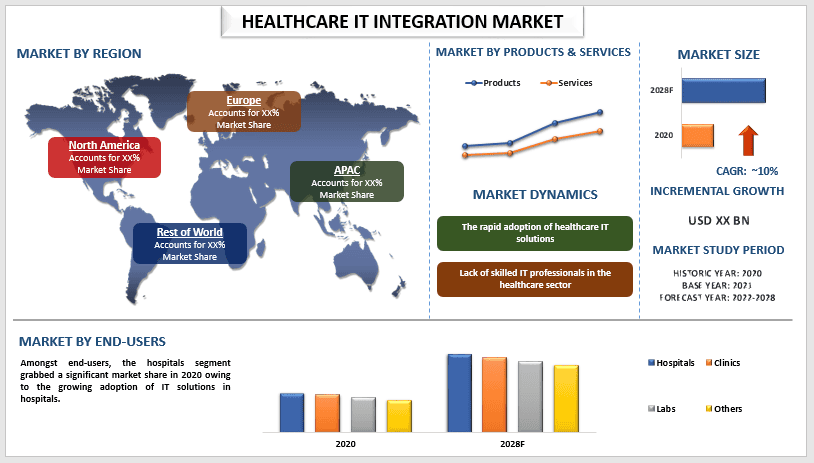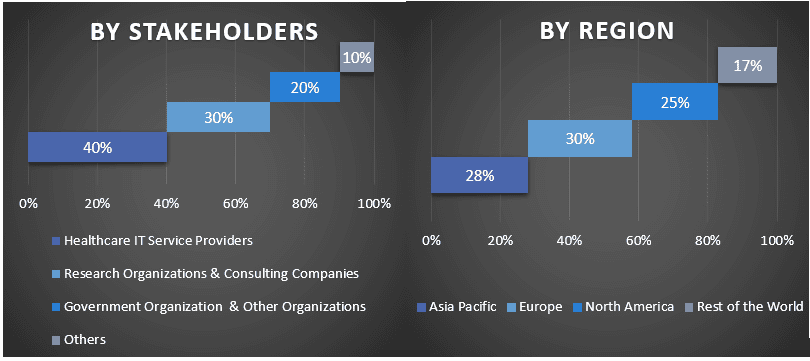- Accueil
- À propos de nous
- Industrie
- Services
- Lecture
- Contactez-nous
Marché de l'intégration des TI dans le secteur de la santé : Analyse actuelle et prévisions (2022-2028)
Accent sur les produits et services (produits (moteurs d'interface/d'intégration, logiciels d'intégration de dispositifs médicaux et autres) et services (services de mise en œuvre, services de support et de maintenance et services de formation)); utilisateurs finaux (hôpitaux, cliniques, laboratoires et autres); et région/pays

Le marché mondial de l'intégration de l'informatique de la santé devrait croître à un rythme important d'environ 10 % au cours de la période de prévision. L'intégration de l'informatique de la santé est un partenariat entre les secteurs de l'informatique et de la santé qui utilise les outils informatiques les plus récents pour surveiller la santé des personnes, partager des données électroniques sécurisées et offrir des options de soins de santé abordables. Les données générées par le secteur de la santé sont énormes et la nécessité de gérer ces données augmente considérablement de jour en jour. Chaque seconde, une énorme quantité de données de santé est générée, et des informations précieuses en sont extraites. Actuellement, environ 30 % du volume mondial de données est généré par le secteur de la santé, et il a été prévu que d'ici 2025, le taux de croissance annuel composé des données pour la santé atteindra 36 %. Par conséquent, afin de minimiser le taux d'erreurs médicamenteuses dans cet énorme ensemble de données et de réduire les coûts de gestion des données, de nombreux établissements de santé déploient des solutions informatiques comme une meilleure alternative aux dossiers physiques. Cela stimule donc le marché de l'intégration de l'informatique de la santé.
Cerner Corporation, Allscripts Healthcare Solutions Inc., Siemens Healthineers, IBM Corporation, GE Healthcare, Epic Systems Corporation, InterSystems Corporation, Corepoint Health LLC, Oracle Corporation, Athenahealth sont quelques-uns des principaux acteurs du marché. Plusieurs fusions et acquisitions ainsi que des partenariats ont été entrepris par ces acteurs pour faciliter l'accès des clients à des produits/technologies de haute technologie et innovants.
Aperçus présentés dans le rapport
"Parmi les produits et services, la catégorie des moteurs d'interface/d'intégration devrait connaître un TCAC robuste au cours de la période de prévision"
En fonction des produits et services, le marché de l'intégration de l'informatique de la santé est segmenté en produits et services. Le segment des produits est ensuite classé en moteurs d'interface/d'intégration, logiciels d'intégration de dispositifs médicaux et autres. De plus, le segment des services est également sous-segmenté en services de mise en œuvre, services de support et de maintenance et services de formation. En 2020, les moteurs d'interface/d'intégration ont accaparé une part de marché considérable en raison du besoin croissant d'échange d'informations au sein des établissements de fournisseurs de services de santé et avec d'autres organisations affiliées.
"Parmi les utilisateurs finaux, les hôpitaux devraient détenir une part importante du marché en 2020"
Sur la base des utilisateurs finaux, le marché est classé en hôpitaux, cliniques, laboratoires et autres. Parmi ceux-ci, les hôpitaux devraient détenir une part importante du marché en 2020. Cela est principalement dû à l'attention croissante portée par les hôpitaux au déploiement de solutions informatiques et à l'intégration croissante des dossiers médicaux électroniques dans divers systèmes hospitaliers afin d'améliorer leurs capacités. En outre, l'utilisation croissante de solutions d'intégration de l'informatique de la santé dans les hôpitaux pour maximiser les remboursements basés sur la valeur et l'augmentation de l'adoption de solutions d'intégration de dispositifs médicaux pour réduire les erreurs médicales et améliorer la qualité des soins sont d'autres facteurs contribuant à la croissance du segment.
"L'Amérique du Nord devrait détenir une part importante du marché"
Pour une meilleure compréhension de l'adoption du marché de l'industrie des véhicules tout-terrain, le marché est analysé en fonction de sa présence mondiale dans les pays tels que l'Amérique du Nord (États-Unis, Canada, reste de l'Amérique du Nord), l'Europe (Allemagne, Royaume-Uni, France, Espagne, Italie, reste de l'Europe), l'Asie-Pacifique (Chine, Japon, Inde, reste de l'Asie-Pacifique), reste du monde. L'Amérique du Nord devrait croître à un TCAC substantiel au cours de la période de prévision. Cela est principalement dû à la forte infrastructure de soins de santé et à l'adoption croissante de solutions technologiques de pointe dans l'industrie des soins de santé dans la région.
Raisons d'acheter ce rapport :
- L'étude comprend une analyse de la taille du marché et des prévisions validée par des experts clés authentifiés de l'industrie.
- Le rapport présente un aperçu rapide de la performance globale de l'industrie en un coup d'œil.
- Le rapport couvre une analyse approfondie des principaux pairs de l'industrie avec un accent principal sur les principaux éléments financiers de l'entreprise, le portefeuille de produits, les stratégies d'expansion et les développements récents.
- Examen détaillé des moteurs, des contraintes, des tendances clés et des opportunités qui prévalent dans l'industrie.
- L'étude couvre de manière exhaustive le marché à travers différents segments.
- Analyse approfondie au niveau régional de l'industrie.
Options de personnalisation :
Le marché mondial de l'intégration de l'informatique de la santé peut être davantage personnalisé selon les exigences ou tout autre segment de marché. En outre, UMI comprend que vous pouvez avoir vos propres besoins commerciaux, alors n'hésitez pas à nous contacter pour obtenir un rapport qui correspond parfaitement à vos besoins.
Table des matières
Méthodologie de recherche pour l'analyse du marché de l'intégration des TI dans le secteur de la santé (2022-2028)
L'analyse du marché historique, l'estimation du marché actuel et la prévision du marché futur du marché mondial de l'intégration des TI dans le secteur de la santé ont été les trois principales étapes entreprises pour créer et analyser l'adoption de véhicules tout-terrain dans les principales régions du monde. Une recherche secondaire exhaustive a été menée pour collecter les chiffres du marché historique et estimer la taille actuelle du marché. Deuxièmement, pour valider ces informations, de nombreuses conclusions et hypothèses ont été prises en compte. De plus, des entretiens primaires exhaustifs ont également été menés avec des experts de l'industrie à travers la chaîne de valeur du marché mondial de l'intégration des TI dans le secteur de la santé. Après l'hypothèse et la validation des chiffres du marché par le biais d'entretiens primaires, nous avons employé une approche descendante/ascendante pour prévoir la taille complète du marché. Par la suite, des méthodes de ventilation du marché et de triangulation des données ont été adoptées pour estimer et analyser la taille du marché des segments et sous-segments de l'industrie concernée. La méthodologie détaillée est expliquée ci-dessous :
Analyse de la taille du marché historique
Étape 1 : Étude approfondie des sources secondaires :
Une étude secondaire détaillée a été menée pour obtenir la taille historique du marché de l'intégration des TI dans le secteur de la santé à partir de sources internes à l'entreprise telles que les rapports annuels et états financiers, présentations de performance, communiqués de presse, etc., et de sources externes, y compris les revues, actualités et articles, publications gouvernementales, publications des concurrents, rapports sectoriels, base de données tierce et autres publications crédibles.
Étape 2 : Segmentation du marché :
Après avoir obtenu la taille historique du marché de l'intégration des TI dans le secteur de la santé, nous avons mené une analyse secondaire détaillée pour recueillir des informations sur le marché historique et partager les différents segments et sous-segments pour les principales régions. Les principaux segments inclus dans le rapport sont les produits et services et les utilisateurs finaux. D'autres analyses au niveau des pays ont été menées pour évaluer l'adoption globale des modèles de test dans cette région.
Étape 3 : Analyse des facteurs :
Après avoir acquis la taille historique du marché des différents segments et sous-segments, nous avons mené une analyse des facteurs détaillée pour estimer la taille actuelle du marché de l'intégration des TI dans le secteur de la santé. De plus, nous avons effectué une analyse des facteurs à l'aide de variables dépendantes et indépendantes telles que divers produits et services et les utilisateurs finaux de l'intégration des TI dans le secteur de la santé. Une analyse approfondie a été menée pour les scénarios de demande et d'offre, en tenant compte des principaux partenariats, fusions et acquisitions, expansion des activités et lancements de produits dans le secteur de l'intégration des TI dans le secteur de la santé à travers le monde.
Estimation et prévision de la taille actuelle du marché
Dimensionnement actuel du marché : Sur la base des informations exploitables tirées des 3 étapes ci-dessus, nous sommes arrivés à la taille actuelle du marché, aux principaux acteurs du marché mondial de l'intégration des TI dans le secteur de la santé et aux parts de marché des segments. Tous les pourcentages requis, la répartition et les ventilations du marché ont été déterminés à l'aide de l'approche secondaire mentionnée ci-dessus et ont été vérifiés par des entretiens primaires.
Estimation et prévision : Pour l'estimation et la prévision du marché, des pondérations ont été attribuées à différents facteurs, notamment les moteurs et les tendances, les contraintes et les opportunités disponibles pour les parties prenantes. Après avoir analysé ces facteurs, les techniques de prévision pertinentes, c'est-à-dire l'approche descendante/ascendante, ont été appliquées pour parvenir aux prévisions de marché pour 2028 pour différents segments et sous-segments sur les principaux marchés mondiaux. La méthodologie de recherche adoptée pour estimer la taille du marché comprend :
- La taille du marché de l'industrie, en termes de revenus (USD) et le taux d'adoption du marché de l'intégration des TI dans le secteur de la santé sur les principaux marchés nationaux
- Tous les pourcentages, répartitions et ventilations des segments et sous-segments de marché
- Principaux acteurs du marché mondial de l'intégration des TI dans le secteur de la santé en termes de produits offerts. De plus, les stratégies de croissance adoptées par ces acteurs pour être compétitifs sur le marché en croissance rapide
Validation de la taille et de la part du marché
Recherche primaire : Des entretiens approfondis ont été menés avec les principaux leaders d'opinion (KOL), y compris les cadres supérieurs (CXO/VP, chef des ventes, chef du marketing, chef des opérations, chef régional, chef de pays, etc.) dans les principales régions. Les résultats de la recherche primaire ont ensuite été résumés et une analyse statistique a été effectuée pour prouver l'hypothèse énoncée. Les commentaires de la recherche primaire ont été consolidés avec les résultats secondaires, transformant ainsi l'information en informations exploitables.
Répartition des participants primaires dans différentes régions

Ingénierie du marché
La technique de triangulation des données a été utilisée pour compléter l'estimation globale du marché et pour parvenir à des chiffres statistiques précis pour chaque segment et sous-segment du marché mondial de l'intégration des TI dans le secteur de la santé. Les données ont été divisées en plusieurs segments et sous-segments après avoir étudié divers paramètres et tendances dans les produits et services et les utilisateurs finaux du marché mondial de l'intégration des TI dans le secteur de la santé.
L'objectif principal de l'étude du marché mondial de l'intégration des TI dans le secteur de la santé
Les tendances actuelles et futures du marché mondial de l'intégration des TI dans le secteur de la santé ont été identifiées dans l'étude. Les investisseurs peuvent obtenir des informations stratégiques pour fonder leur discrétion en matière d'investissements sur l'analyse qualitative et quantitative effectuée dans l'étude. Les tendances actuelles et futures du marché ont déterminé l'attractivité globale du marché au niveau régional, offrant une plate-forme aux participants industriels pour exploiter le marché inexploité afin de bénéficier d'un avantage de premier arrivé. Les autres objectifs quantitatifs des études comprennent :
- Analyser la taille actuelle et prévisionnelle du marché de l'intégration des TI dans le secteur de la santé en termes de valeur (USD). De plus, analyser la taille actuelle et prévisionnelle du marché des différents segments et sous-segments
- Les segments de l'étude comprennent les domaines des produits et services et des utilisateurs finaux
- Définir et analyser le cadre réglementaire de l'intégration des TI dans le secteur de la santé
- Analyser la chaîne de valeur impliquée avec la présence de divers intermédiaires, ainsi qu'analyser les comportements des clients et des concurrents de l'industrie.
- Analyser la taille actuelle et prévisionnelle du marché de l'intégration des TI dans le secteur de la santé pour la région principale.
- Les principaux pays des régions étudiées dans le rapport comprennent l'Asie-Pacifique, l'Europe, l'Amérique du Nord et le reste du monde.
- Profils d'entreprise du marché de l'intégration des TI dans le secteur de la santé et stratégies de croissance adoptées par les acteurs du marché pour se maintenir sur le marché en croissance rapide
- Analyse approfondie au niveau régional de l'industrie
Connexes Rapports
Les clients qui ont acheté cet article ont également acheté










